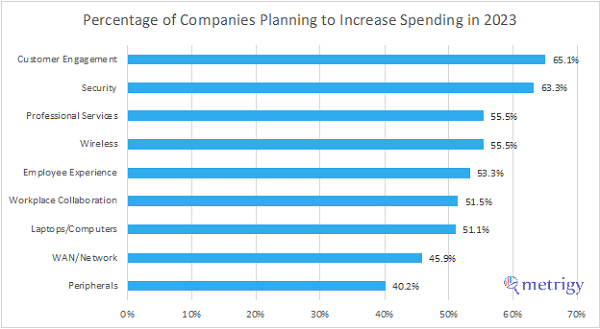With the global economic uncertainty and layoffs, particularly among technology companies, it’s not surprising that many are wondering what 2023 will bring for technology spending.
The good news is that business leaders are prioritizing technology spending—and most areas will see impressive increases in spending with customer engagement at the top of the list, according to Metrigy’s 2023 Technology Spending Forecast research study, conducted in late August.
When it comes to overall business budgets, 49.4% of companies plan to slow their spending, while only 25.7% plan to increase spending (the rest will stay flat). In addition, hiring and travel already have slowed , while employee compensation is holding steady.
The news is much better for technology, though. Despite the fact that only about a quarter of companies will increase overall business spending, 49% plan to increase their total tech spending in 2023 by an average of 25.9%. The top three areas for spending include customer engagement, security, and professional services. More than half of companies also will increase spending on wireless, employee experience, workplace collaboration, and laptops/computers.
The spending outlook for customer engagement shows 65.1% of companies plan to increase spending by an average of 24% in 2023. What’s more, the fewest number of companies (9.6%) plan to decrease spending on customer engagement compared to other technologies we measured. Through the end of the year, though, half of the companies will keep customer engagement spending flat, and only 29.8% will increase spending from their budgeted amount—not too unusual, particularly in this business climate.
Drivers for Customer Experience Spending
Business leaders see the value of investing in customer experience (CX). Our research shows that 85.3% of companies prioritize customer satisfaction over agent productivity—a shift from years past—when business leaders viewed contact centers as cost centers and tried to keep costs down regardless of customer fallout.
Now, that’s changed. Technology is tightly tied to both customer and employee satisfaction. It can make the contact center more productive, while ensuring customers are satisfied. In fact, the top reason 41.9% of companies will boost spending is that the technology has proven to reduce overall operational costs. Technologies such as Workforce Optimization, agent assist, and overall analytics are hugely helpful in that goal. They also said customer demand for self-service/non-voice channels is so high they can’t stop investment now.
Another core reason is that they need CX technologies to account for contact center staffing shortages. We also found that when companies are short agents (and about half are now), they spend 52.9% more on CX technologies, according to our Customer Engagement Transformation 2022-23 global research study. Technology, such as agent assist, helps them retain agents and avoid high turnover rates.
Research participants also said the economic downturn gives them an opportunity to invest in CX to gain a competitive advantage. If competitors reduce spending on advanced CX technologies, they believe they can accelerate investment; and come out of the downturn in a strong position—potentially securing new customers because they offer such good customer service.
Perhaps understated, but still a reason referenced by 26.4% of CX leaders, is because customers wield too much power through social media and online ratings to risk-reducing spending. For example, they must keep the staff and the tools to monitor social media, evaluate and make changes based on their ratings, and continue to provide solid service. Cutting technology spending will undoubtedly reduce service levels for customers—and CX leaders aren’t willing to take the risk of poor reviews.
CX Technologies with Planned Increases
CX leaders plan to increase spending on several technologies. The highest percentage of companies plan to increase spending on workforce optimization, voice of customer programs, quality management, and workforce management. But regarding actual spending increase percentages, Natural language processing, voice biometrics, and contact center performance management tools post the highest, ranging from 22% to 29%.
The overall takeaway from the study is that technology is front-and-center among both technology and business leaders. It helps to automate operations and improve both customer and employee experience. My big recommendation: Gather insights from customers and employees—and act on the analysis from that information. Otherwise, you’re flying blind—and could make some costly mistakes.











